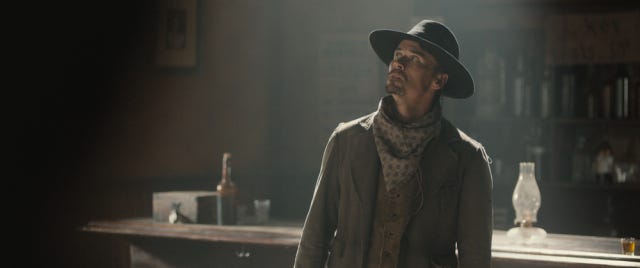The Gunfighter
…said the voice.
Eric Kissack’s 2014 short film The Gunfighter depicts the story of a gunfighter entering a saloon as a narrator describes his actions. To an audience, this seems normal at first, until it is revealed that everyone in the saloon can hear the narrator as he discusses all of their actions, thoughts and feelings. This quickly turns into a very embarrassing and humiliating conversation for everyone in the saloon, as the narrator spills secrets about the characters within the room, which is hilarious to watch. It is revealed by the narrator that everyone in the bar has committed a crime or adultery, and even everyone finds out that the gunfighter is gay. They all turn on each other and initiate a Mexican standoff, all because of the narrator’s doing. However, the gunfighter makes a speech and forms a utopia with everyone in the saloon, until the narrator reveals that the gunslinger killed the son of one of the patrons, so everyone decides to shoot each other. The only survivor is Sally, but the narrator discloses that she will be killed the next day by a rabid wolf.
Narrative Structure:
The most notable aspect of this short film is the narrator, and how it is also heard by the characters and is some kind of omniscient, powerful being that controls the narrative. It’s as if the characters know that they are in a film, as the narrator is completely normal to them at first as he describes the gunfighter walking into the saloon, but when the voice begins to say the characters’ thoughts, they begin to feel suspicious. The whole film is shot over just two locations, the exterior and interior of the saloon, which makes it easier to focus on the story and the comedy. The plot is linear, and characters act in conflict with each other throughout the film until the end, as they go from wanting to secretly kill each other, to coming together and forming a community (until they shoot each other at the end). The narrative structure of The Gunfighter is quite simple, but the unique use of the diegetic narrator, voiced by Nick Offerman, makes it more entertaining.
Cinematic Influences:
I would say that The Gunfighter clearly has a Western genre, but is also a hybrid of a comedy and a drama, as tension rises as everyones’ secrets are revealed, but it does have a comedic surface. This is quite unusual for the time of the film’s creation (2014) because America was not producing many Western films during this era, which contributed to this film’s popularity and success. The film’s cinematography is memorable because the composition is balanced due to the action being in one third of the frame, and the most frequent camera angle used is the eye-level shot, so that the actors can progress the story, as we immediately focus on them. The lighting was one of my favourite aspects of the film because there was a natural beam of sunlight (achieved through potentially a profile spot) that lit up above the gunfighter to highlight that he is character of significance. I enjoyed the film’s editing because it is quite slow-paced and is not disorienting because it follows the 180 degree rule. The sound was an important aspect within this short film because of the Western-style score that was added in post-production, and obviously the diegetic narration that structured the narrative. The mise-en-scène was effective because the props and set contributed to the audiences’ understanding that it was set in a Western location, and costumes allowed us to understand the personality of each character, even before being introduced to them. Finally, the performances in The Gunfighter were memorable because the actors broke the fourth wall through communicating with the narrator, and the blocking allowed for an interesting use of physicality, as some actors would have to turn to face another actor, which created a sense of urgency, which added to the film’s comedy. Proxemics showed which characters were close, for example, the Henderson brothers. The power levels were shown through performance, as the gunfighter would hold his head high to show his status above the other characters, but would look away in shame when the narrator revealed his secrets.
Creating Meaning and Effect:
The film is based around a group of characters who all fit the ‘old west’ stereotypes, as they all have that accent and display violence against others in the tavern. However, the film does reject these stereotypes, as the narrator reveals the insecurities and vulnerabilities of each character and makes them not as scary as they are first perceived. Eric Kissack has used a warm colour palette with a widescreen aspect ratio to create the environment of the old west. I believe that this style is ironic because it contrasts the less dramatic and comedic tone of the film.
Overall, I really enjoyed The Gunfighter because of its unexpected comedic twist, as at first I got the impression that this would be an action-packed Western film, but the way the characters acknowledged the presence of the narrator as if it was part of the world of film instead of an expository storytelling device made the film very funny. It was hilarious to observe as the narrator annoyed and humiliated the characters as he revealed their thoughts, and the difference in the personalities of each character was entertaining to watch because of their contrasting lives, but their secrets allowed the most unexpected group to bond, despite their hatred for each other at first.
⭐️⭐️⭐️⭐️⭐️



